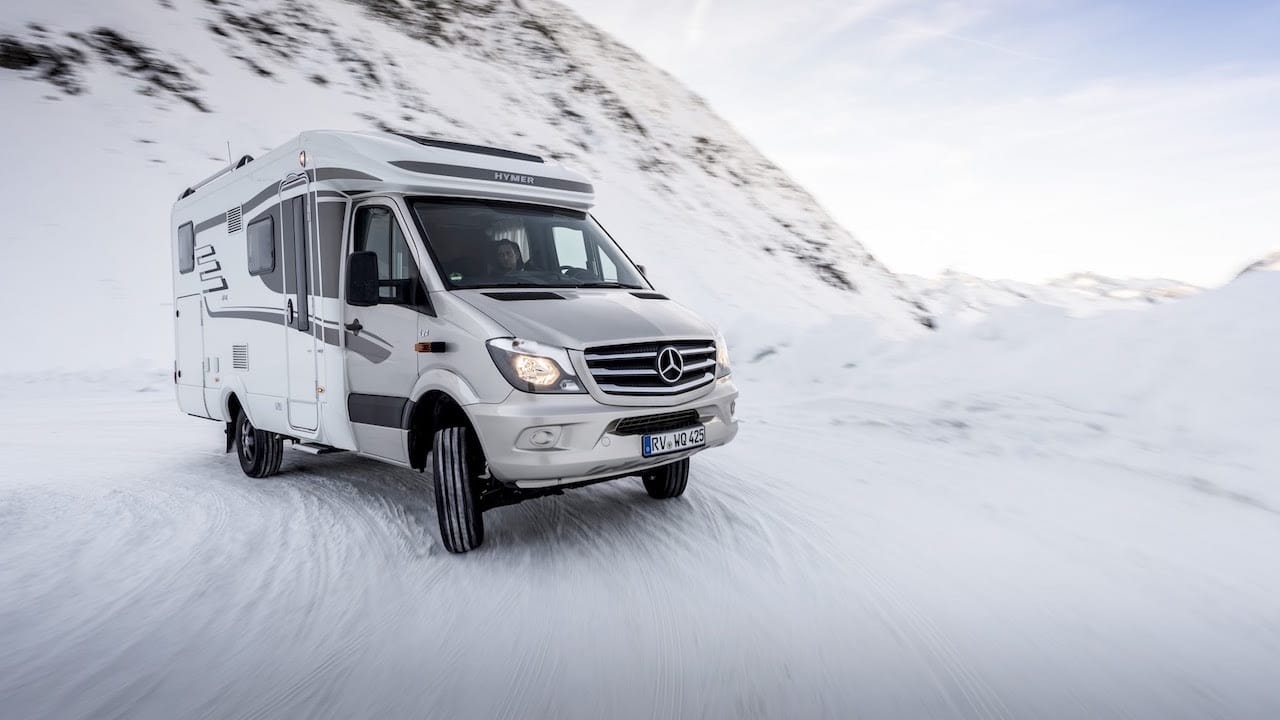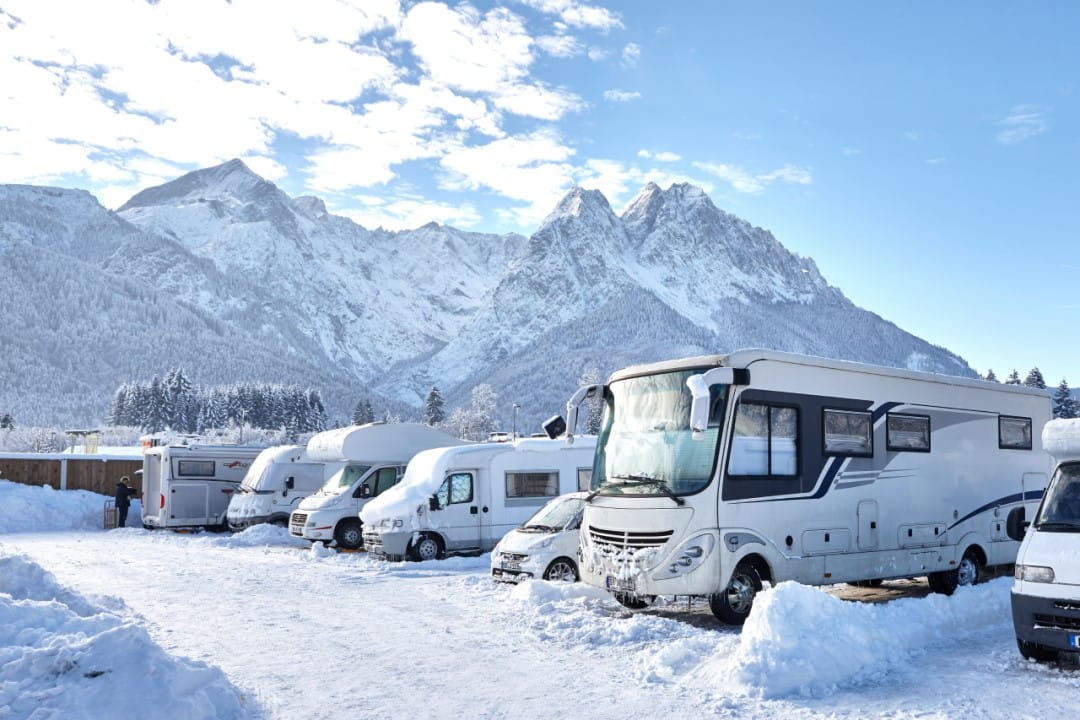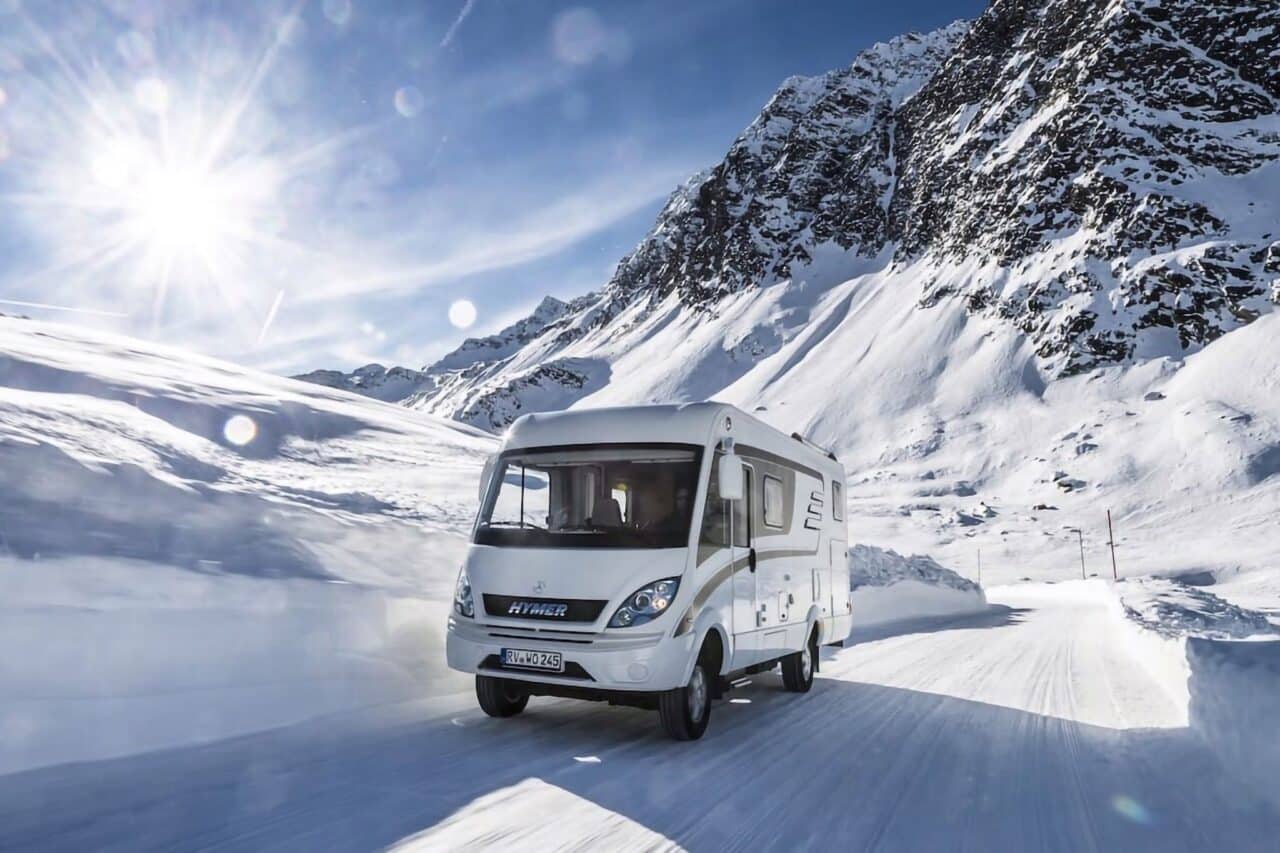Don’t want to miss out on camping in winter? No problem! The cold season has its very own charm. However, there are a few things to consider before you set off in your caravan or motorhome to a snowy region – and that doesn’t just mean winter tires.
Inhaltsverzeichnis
How to make winter camping fun: 10 helpful tips
Here you will find tips to make winter camping a real pleasure.
1. winter tires are a must
In Germany, winter tires have long been a legal requirement. If you are caught here in snow or ice without one, you will pay 60 euros and get a point in Flensburg. You face even higher penalties if you obstruct other vehicles or cause an accident.
Although this only applies to the towing vehicle, if you really want to be out and about in snow and ice, winter tires are also a good idea for your caravan. They prevent the vehicle from sliding sideways on sloping roads and ensure greater overall driving stability.

2. replenish gas supplies and top up if necessary
Depending on the weather, a 12-liter bottle will only last for three to four days when winter camping, which of course depends on your personal comfort temperature. But you probably won’t want to heat more, you’ll also want to consume more hot drinks, soups and hot meals than in warmer weather. You are therefore well advised to always take a full spare bottle with you.
It is convenient if your motorhome or caravan has a gas level indicator; a Duo-Control system is even better: you connect both cylinders and the system simply switches – oh wonder – from the empty to the full cylinder.
And if the bottle is empty at night, a small fan heater can also help for the time being. But beware: most of them are real power guzzlers and, depending on the electricity price on site, you will pay between 50 cents and 1.00 euro per hour of heating!
Info
You can find our detailed article on the topic of gas when camping here: Gas cylinders for camping – variants, filling, safety tips.
3. heating, ventilation and keeping out cold air
In cold weather and in confined spaces, it is particularly important not only to heat but also to ventilate. For a comfortable indoor climate, the room temperature and humidity should not be above the maximum or below the minimum value.
“Shock ventilation” is the magic word here – so turn off the heating several times a day, open everything up and let in fresh air. Just a few minutes will suffice. As fresh air warms up faster than damp and stale air, your home should be warm again quickly.
tip
Open the cupboards every few days. This will prevent cold, damp air from collecting here and causing a musty smell or mildew stains. Of course, it also makes sense to choose a location that is exposed to the sun. This allows you to use the solar heat naturally during the day, especially if you have a solar system on your roof.
Important when it snows: Check the fresh and exhaust air of your heating system regularly to ensure that nothing is blocked. Even if there is a draught inside, the supply air openings must never be completely closed. However, some manufacturers offer extra winter covers.
Additional draught excluders in front of the door also help. You should also regularly check the insulation on doors and windows for damage and replace it immediately if necessary.
4. warm feet and climate zones
If your caravan or motorhome doesn’t have the luxury of underfloor heating, you can prevent icy feet by placing sleeping mats on the floor, for example. If you like, you can also lay out sheepskins. If your caravan is parked in one place for a longer period of time, a so-called “floor skirt” can also help: This is fitted around the caravan and reduces the draught of cold air under the vehicle floor.
Coated thermal curtains are also available for motorhomes, which are fitted between the driver’s cabin and the living area. They create different climate zones in the motorhome and prevent cold air from entering the vehicle from the front. It is also worth covering the large windshield with a coated thermal mat.
5. erect awning
Of course it is! At least if you’re staying at the same place for a few days longer, it’s worth putting up the awning. It is not only additional storage space, but also a dirt trap and cold trap at the same time. But of course there are special winter tents, because a lightweight summer tent is only suitable for winter use to a limited extent.
Winter tents are made of more robust, coated material and are also often shorter in order to reduce the roof area and therefore the roof load in the event of snowfall. The roof also has a steeper slope so that the snow has less chance of sticking to it.
Info
You can find more information about awnings for caravans in this article: Awnings for caravans – market overview and tips for buying.
There are special heaters for heating an awning – however, you should always ensure adequate ventilation when using them. Combustion produces carbon monoxide – an absolutely odorless, highly toxic and therefore deadly gas!
I’m a safety freak myself and not only have a smoke detector in my motorhome, I also take a CO₂ detector with me. You can get one at any DIY store and it reliably warns you if the CO₂ content in the air you breathe rises above a certain level.
6. dry damp clothing and equipment
Drying clothes and sports equipment can be a real task when winter camping. It is really good if the campsite has a drying room, but unfortunately this is not always the case.
Another option is to equip the bathroom cubicle with a rail and hooks or hangers and dry your clothes by turning the heating up completely and opening the window a little.
Not exactly energy-saving, but often there are hardly any other options. An awning heated with a gas stove is of course also a good place to dry wet clothes and shoes. If you stuff the shoes with newspaper, this will also absorb the moisture inside.
Attention
You should not place leather shoes in close proximity to the fan heater, otherwise the leather will become brittle.
7. frost monitor and frost protection
If you are camping in temperatures around zero or below, you should make absolutely sure that your water pipes cannot freeze. If your motorhome or caravan has heated water tanks, everything is fine. Otherwise, retrofittable heating coils can help to prevent frost damage to the water system.
But watch out for the waste water tank! This is often not heatable. In this case, it helps to let the waste water flow directly into a container placed underneath and to dispose of it frequently. Adding a little antifreeze to the drains also prevents the pipes from freezing.
Info
You can find more tips and a checklist here: Checklist: Winterizing caravans and motorhomes (with video!).
8. off to the grid
Even if it is nice to be completely self-sufficient: In winter, it is once again worth connecting to the campsite’s power supply. For one thing, the on-board battery may not last as long as usual – at least if it is installed in such a way that it is exposed to the cold.
On the other hand, your consumption will probably increase because you need more light and spend more time indoors than in summer and perhaps also use your tablet or similar more often. You can also use the external power to run the fridge.
9. upgrade equipment
A basic set of tools should always be on board. However, telescopic poles (e.g. from garden supplies) are also a great aid when traveling in winter. For example, you can mount ice scrapers or brooms on them to clear large windows of ice or sweep snow off the roof.
And, of course, a shovel for shoveling snow is a must! From personal experience, I would also always recommend taking a starter cable with you. You wouldn’t believe how many people are on the road without one … 😊 In addition, different cables are suitable for diesel and petrol engines.
10. reserve the best place
Of course it’s nice to just set off. But not all places are open in winter and some simply offer more than others – sauna or wellness, for example. So it goes without saying that particularly attractive destinations book up quickly. In this case, booking in advance simply protects you from disappointment.
Info
In this article you will find some beautiful places for winter camping: Winter camping: The most beautiful campsites for the cold season

What does “winterized” or “winter-proof” mean?
Suitable for winter? Winter-proof? Sounds like the same thing at first. In reality, however, the two terms mean different things and there are also DIN standards for them. DIN EN 1645-1 and DIN EN 1646-1 each describe a precisely specified test procedure for caravans and motorhomes, which determines whether a manufacturer may describe their vehicle as “winter-proof”.
- Winter-proof therefore means that a motorhome or caravan can be heated back up to a room temperature of 20 °C within two hours after cooling down to 0 °C for at least ten hours. In addition, the room temperature must not differ by more than 7 °C at five measuring points in the interior.
- In order for a model to be described as “winter-proof“, it is cooled to minus 15 °C in the test procedure and must then be warmed up again to 20 °C within four hours using the on-board heating system. In addition, the water system is also tested one hour after reheating. Nothing must freeze and it must function without restrictions.
You can only find out whether your vehicle or trailer meets one of the two standards when buying used by checking the manufacturer’s specifications – for example, by looking in the owner’s manual or asking the manufacturer. There is no corresponding entry in the vehicle documents.
Tip
So if you are actually planning a longer tour in sub-zero temperatures, your mobile home should be designated as winter-proof by the manufacturer. Freezing is not nice, but a frozen water system can also be really expensive.
Expert interviews on the topic of winter camping
Our podcast also features exciting episodes on the subject of winter camping, in which the topic is explored in more detail. Nele & Sebastian have invited experts to give lots of tips on winter camping.
1. winter camping tips: Vehicle, dog, campsites
Expert tips for winter camping: What do you need to know about camping vehicles? What do you need to know at the campsites? And how does winter camping with a dog actually work? Nele and Sebastian reveal all in this podcast episode. Listen in now:
2. on a winter vacation with a caravan or motorhome?
An expert interview with four guests who have very different views on winter camping. Be sure to listen in:
3. easy-to-implement tips & tricks for winter camping
An expert interview with Jürgen Rode from Womo.blog, who has some great tips and tricks for winter camping. Be sure to give it a listen:
Conclusion
Winter camping requires a little more preparation and equipment than camping in summer. However, the experience is in no way inferior to summer camping! But with the right equipment on board, it can be a wonderful, cozy camping experience that is in no way inferior to your summer vacation. And who wouldn’t want to fall into their own cozy bed after a long day on the slopes or a walk in the snow?
Cover photo: © Hymer GmbH & Co KG

